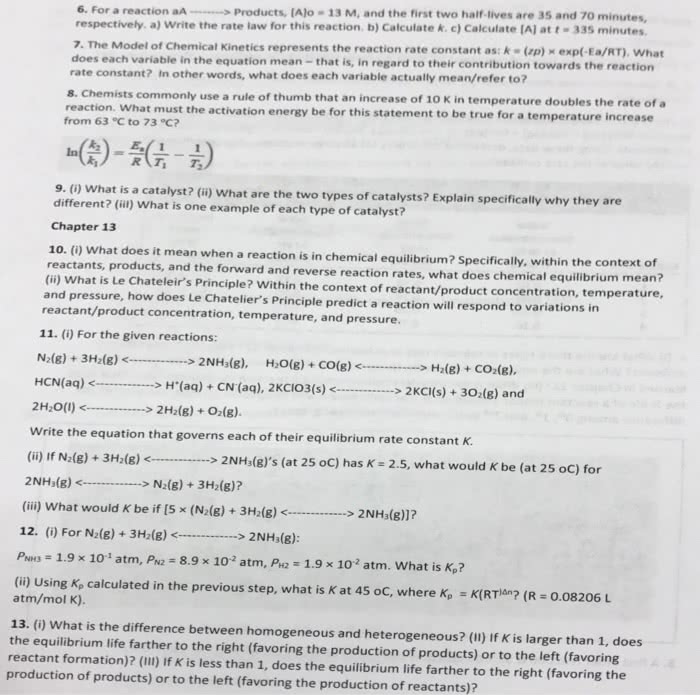CHM 1046 Lecture Notes - Lecture 32: Equilibrium Constant, Chemical Formula, Vise
25 views4 pages
Document Summary
Note: doesn"t have any units equilibrium constant equation. 2a (g) + 3b (g) 4c (g) The more products you have, the larger the k(eq). - rxn lies to the right, rxn goes mainly forward. The less products you have, the smaller the k(eq). - rxn lies to the left, rxn goes mainly reverse. -- reactants predominate equilibrium constant rules constants are multiplied rules for adding two reactions (in terms of equilibrium constants) Used to predict whether the reaction is going forward or reverse. It s compared to the equilibrium constant. (cid:374): su(cid:373) of coefficie(cid:374)ts of (cid:894)gas(cid:895) products (cid:373)i(cid:374)us su(cid:373) of coefficie(cid:374)ts of (cid:894)gas(cid:895) reacta(cid:374)ts. How to convert from k(c) to k(p)? (conversion equation). (cid:374): su(cid:373) of coefficie(cid:374)ts of (cid:894)gas(cid:895) products (cid:373)i(cid:374)us su(cid:373) of coefficie(cid:374)ts of (cid:894)gas(cid:895) reactants. How to convert from k(p) to k(c)? (conversion equation). Le chatelier"s principle says when a system at equilibrium is disturbed, it counteracts the disturbance by either going forward or reverse.
Get access
Grade+20% off
$8 USD/m$10 USD/m
Billed $96 USD annually

Homework Help
Study Guides
Textbook Solutions
Class Notes
Textbook Notes
Booster Class
40 Verified Answers
Class+
$8 USD/m
Billed $96 USD annually

Homework Help
Study Guides
Textbook Solutions
Class Notes
Textbook Notes
Booster Class
30 Verified Answers
Related Documents
Related Questions
Hydrogen is used as a rocket fuel because it is very light and reacts explosively and completely with oxygen. For the combustion reaction 2H2(g)+O2(g)â2H2O(g) what is the likely magnitude of the equilibrium constant K?
| 1.K<10â3 |
| 2.10â3<K<103 |
| 3.K=0 |
| 4.K>103 |
PART B
The industrial production of lime (CaO) from calcium carbonate is accomplished via the following reaction:
CaCO3(s)âCaO(s)+CO2(g)
Given the following data:
| Temperature (K) | K |
| 298 | 1.93Ã10â23 |
| 1200 | 1.01 |
what can be said about this reaction?
| 1.Lower temperatures result in more lime formation. |
| 2.The reaction makes more lime at higher temperatures. |
| 3.The reaction goes to completion at 1200 K. |
| 4.The equilibrium lies far to the right at room temperature. |
PART C
For the reaction
2H2S(g)â2H2(g)+S2(g), K= 1.00Ã10â6 at 1000 K
what can be said about this reaction at this temperature?
| 1.The equilibrium lies far to the right. | ||||
| 2.The reaction will proceed very slowly. | ||||
| 3.The reaction contains significant amounts of products and reactants at equilibrium. | ||||
| 4.The equilibrium lies far to the left. PART D For the reaction HCONH2(g)âNH3(g)+CO(g), K= 4.84 at 400 K what can be said about this reaction at this temperature?
|

